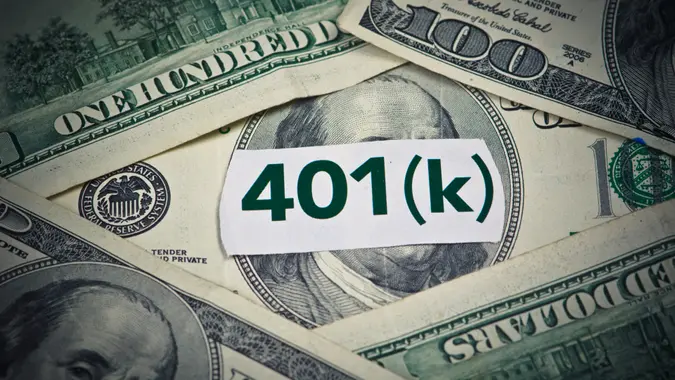What Is a Roth IRA Conversion and How Does It Work?

Commitment to Our Readers
GOBankingRates' editorial team is committed to bringing you unbiased reviews and information. We use data-driven methodologies to evaluate financial products and services - our reviews and ratings are not influenced by advertisers. You can read more about our editorial guidelines and our products and services review methodology.

20 Years
Helping You Live Richer

Reviewed
by Experts

Trusted by
Millions of Readers
A Roth IRA conversion lets you move money from a traditional IRA or 401(k) into a Roth IRA. You’ll pay taxes on the amount you convert now, but you’ll gain tax-free growth and withdrawals later in retirement.
In simple terms: you’re trading a short-term tax bill for long-term tax freedom. For many savers — especially those expecting higher taxes in the future — that can be a smart move.
According to Fidelity, more than 1 in 5 retirement savers completed or planned a Roth conversion in the past year, as tax-efficient strategies grow in popularity among retirees.
Here’s what to know about the rules, taxes and best timing for a Roth IRA conversion — plus how to decide if it fits your long-term financial goals.
Quick Facts: Roth IRA Conversion
| Key Detail | Summary |
|---|---|
| What It Is | Moving money from a pre-tax IRA or 401(k) into a Roth IRA |
| Tax Treatment | Pay taxes now; enjoy tax-free growth later |
| Income Limits | None for conversions |
| 5-Year Rule | Wait 5 years for tax-free earnings withdrawals |
| Best Time to Convert | During low-income years or market dips |
Why Consider a Roth IRA Conversion?
The biggest appeal of a Roth IRA conversion is long-term tax savings. Once you convert and pay taxes on the money, your future withdrawals — including investment growth — are completely tax-free.
Here are some of the top reasons investors choose this strategy:
- Tax-Free Income Later: Future withdrawals aren’t taxed, even if rates rise.
- No RMDs: Unlike traditional IRAs, you’re not required to withdraw funds at age 73.
- Estate Planning Benefits: Heirs can receive tax-free distributions, preserving more of your legacy.
- Tax Diversification: A Roth account helps balance taxable and tax-free income in retirement.
How a Roth IRA Conversion Works
Converting to a Roth IRA is a taxable event. When you move pre-tax funds — from a traditional IRA, SEP IRA, SIMPLE IRA (after two years) or 401(k) — the amount you convert is added to your taxable income for that year.
If you convert $50,000, that $50,000 is taxed as ordinary income. Depending on your total earnings, this could bump you into a higher tax bracket, so timing matters.
Conversion Options
- Direct (Trustee-to-Trustee) Transfer: Safest and simplest — funds move directly between institutions, avoiding withholding taxes.
- 60-Day Rollover: You receive funds and must deposit them into your Roth IRA within 60 days to avoid penalties.
- Gradual Conversions: Convert in smaller amounts over several years to stay in a lower bracket and reduce your annual tax hit.
Taxes on Roth IRA Conversions
There are several tax rules and considerations to keep in mind when it comes to Roth IRA conversions. Here’s a breakdown of some of the most important:
Conversion Taxed as Ordinary Income
The converted amount is taxed at your regular income rate. Federal tax brackets in 2025 range from 10% to 37%, depending on your income.
For example:
- If you earn $100,000 and convert $20,000, your taxable income rises to $120,000.
- That could bump part of your income into a higher bracket, costing an extra $2,000 to $3,000 in taxes.
| Tax Bracket | Single Filer Range (2025) | Example Conversion Impact |
|---|---|---|
| 12% | Up to $47,150 | Low-income years are ideal for conversions |
| 22% | $47,151 – $100,525 | Convert modest amounts to stay in the bracket |
| 24% | $100,526 – $191,950 | Avoid large one-time conversions |
| 32%+ | Over $191,951 | Convert modest amounts to stay in the bracket |
Schwab recommends converting smaller portions annually to “ladder” your taxes and keep your income in check.
State Taxes and Medicare Surcharges
Your state may tax conversions, too. States like California and New York tax all IRA income, while states like Florida and Texas don’t.
Also, because conversions increase your modified adjusted gross income (MAGI), your Medicare premiums could rise temporarily due to IRMAA surcharges, which affect high earners making over $103,000 (single) or $206,000 (married) in 2025.
The 5-Year Rule for Roth Conversions
Each conversion has its own five-year waiting period before you can withdraw earnings tax-free. The clock starts on January 1 of the year you convert.
If you take out money earlier — and you’re under 59½ — you’ll owe a 10% penalty plus taxes.
Here’s a simple example:
If you convert funds in 2025, you can withdraw your earnings tax and penalty-free starting January 1, 2030 (assuming you’re 59½ or older).
IRS data shows early withdrawals are one of the top causes of tax penalties among retirement savers, costing Americans over $6 billion in penalties annually.
Benefits of a Roth IRA Conversion
- Tax-Free Growth and Withdrawals: Once converted, all future earnings and qualified withdrawals are tax-free.
- No RMDs: Roth IRAs don’t require minimum distributions, giving you more control.
- Estate Planning Advantages: Beneficiaries inherit tax-free assets, minimizing the tax burden.
- Tax Flexibility in Retirement: With both pre-tax and post-tax savings, you can better manage your income and tax exposure each year.
| Pros | Cons |
|---|---|
| Tax-free growth and withdrawals | Large upfront tax bill |
| No RMDs (withdraw anytime) | May raise Medicare premiums temporarily |
| Tax-free inheritance for heirs | Risk of a higher bracket in the conversion year |
| Flexibility for future withdrawals | Risk of a higher bracket in the conversion year |
Drawbacks and Risks
- Large Tax Bill in Conversion Year: The converted amount counts as income, so converting too much at once can cause a tax spike.
- Possible Medicare Premium Increases: Higher income after conversion could trigger short-term surcharges.
- Less Liquidity: If you pay conversion taxes using IRA funds, you’ll reduce your total savings and possibly face penalties if you’re under 59½.
When a Roth IRA Conversion Makes Sense
You’ll likely benefit most from a Roth IRA conversion if:
- You’re in a low-income year, like early retirement or during a market downturn.
- You expect higher taxes in the future (the current lower rates under the 2017 Tax Cuts and Jobs Act expire in 2026).
- You want to avoid RMDs and create tax-free retirement income.
- You’re doing estate planning and want to pass wealth tax-free to heirs.
Alternatives to a Roth IRA Conversion
- Backdoor Roth IRA: High earners can contribute to a traditional IRA, then convert those funds into a Roth — bypassing contribution income limits.
- Traditional IRA: If you expect to be in a lower tax bracket later, it may make sense to stay with tax-deferred savings.
- Taxable Brokerage Account: Offers flexibility and liquidity, though gains are taxed annually.
Final Take to GO: A Smart Move — If You Plan It Right
A Roth IRA conversion can be a powerful way to reduce future taxes and create lifelong tax-free income — but only if you time it right. The key is to convert gradually, plan for the tax bill and avoid using your retirement funds to pay conversion taxes.
Final Take: If you expect to be in a higher tax bracket later, converting now could save you significantly in the long run. Talk with a financial or tax advisor to build a conversion plan that fits your income, timeline and retirement goals.
Use the GoBankingRates Retirement Calculator to estimate how a conversion could affect your future savings.
FAQs: Roth IRA Conversion Rules and Strategies
Here are answers to the most common questions about Roth IRA conversions:- How much tax do you pay on a Roth IRA conversion?
- It depends on your income and conversion size. The amount converted is taxed as ordinary income for that year. Spreading conversions over several years can help manage taxes.
- Is there an income limit for Roth IRA conversions?
- No. Anyone can convert -- regardless of income. That’s why many high earners use the strategy to get Roth benefits.
- Does each conversion have a 5-year rule?
- Yes. Every Roth conversion starts its own five-year clock for tax-free withdrawals.
- When’s the best time to convert?
- During low-income years, market downturns, or early retirement, your tax rate is likely to be lowest.
- Can I convert part of my IRA each year?
- Yes, partial conversions are allowed and often the smartest approach. It helps you avoid large tax spikes and manage your income more efficiently.
Information is accurate as of Oct. 23, 2025.
Editor's note: This article was produced via automated technology and then fine-tuned and verified for accuracy by a member of GOBankingRates' editorial team.
Our in-house research team and on-site financial experts work together to create content that’s accurate, impartial, and up to date. We fact-check every single statistic, quote and fact using trusted primary resources to make sure the information we provide is correct. You can learn more about GOBankingRates’ processes and standards in our editorial policy.
- IRS "Retirement topics - Exceptions to tax on early distributions"
- Fidelity "What is a Roth IRA?"
- Fidelity "Why convert to a Roth IRA now?"
- IRS "IRS releases tax inflation adjustments for tax year 2025"
- Charles Schwab "3 Strategies for Reducing Roth Conversion Taxes"
- U.S. Social Security Administration "Premiums: Rules for Higher-Income Beneficiaries"
 Written by
Written by  Edited by
Edited by 
























